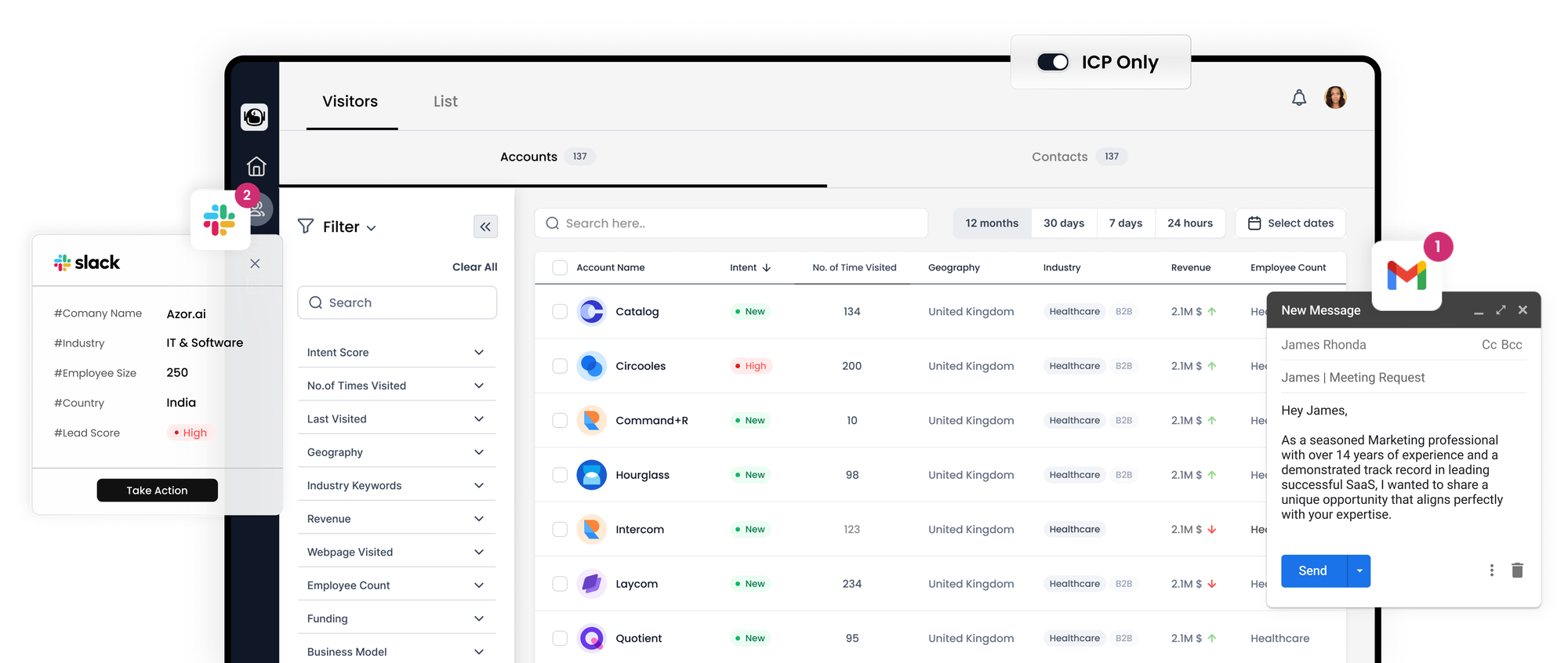Enhancing Business Strategy with Website Visitor Tracking: Methods and Tools

Investing in creating, maintaining, and driving traffic to a website is a significant part of a company's budget. This investment is crucial as a website often serves as the first point of interaction between potential customers and the brand. Making a positive first impression is therefore essential.
However, the journey doesn't end with just attracting visitors to your site. Typically, only about 2% of visitors will actively inquire or leave their contact details, leading to a potential loss of engagement with the remaining 98%. To bridge this gap, various website visitor tracking tools and strategies come into play, offering insights even when visitors don't leave their contact information.

Types of Website Visitor Tracking and Their Utility
1. IP Tracking
- An IP address is a unique number assigned to a computer or network.
- Website analytics tools utilize IP addresses to determine visitors' approximate geographic locations, providing valuable data about the audience's demographics.
- Advanced tools, like Lead Forensics, can identify the visiting company and even provide contact details of key decision-makers within that organization.
2. Device Tracking
- Analytics tools can track the type of device used to access your site, such as a PC, tablet, or mobile phone, and even specific device models and brands.
- This information aids in optimizing the website for the most popular devices, ensuring an optimal user experience.
3. Pixel Tracking
- Marketing pixels, or tracking pixels, are small pieces of code embedded in websites or emails. They generate a tiny, transparent 1×1 pixel image that remains invisible to users.
- These pixels help monitor user behavior, site conversions, web traffic, and other valuable metrics.
- For instance, pixel tracking can reveal if users have opened an email newsletter or visited a specific webpage, offering insights into their interactions and preferences.
Implementing Website Visitor Tracking for Enhanced Engagement
- Utilizing these tracking methods allows businesses to gain deeper insights into their website visitors' behavior and preferences.
- This data can be instrumental in refining marketing strategies, tailoring content, and improving user experience.
- By understanding visitor behavior better, businesses can effectively re-engage those who did not initially leave contact details, potentially converting them into leads or customers.
- Implementing visitor tracking is also crucial for optimizing website performance and personalizing user interactions, leading to increased customer satisfaction and loyalty.
In conclusion, website visitor tracking is a vital tool for businesses seeking to maximize their online presence and engagement. By leveraging the different types of tracking available, companies can not only understand their audience better but also enhance their marketing strategies and website functionalities to cater to the specific needs and preferences of their visitors. This approach ultimately leads to a higher conversion rate, better customer engagement, and improved ROI.
Essential Features to Look for in Website Visitor Tracking Software
When selecting website visitor tracking software, it's crucial to choose one that not only captures comprehensive data but also provides actionable insights in real-time. This section outlines key features you should consider to effectively transform website visitors into valuable leads.
1. Real-Time, Categorized Data Delivery
- Opt for software that delivers critical data in real-time, including each visitor's business name, company size, industry, location, website, and complete contact details.
- Advanced tracking software should offer insights into visitors' on-site behavior, such as search queries, pages viewed, frequency of visits, and duration of stay.
- Look for capabilities to categorize visitors based on the buyer's journey stages (awareness, consideration, decision) to tailor your outreach and engagement strategies effectively.
2. Prioritizing High-Quality Leads
- The software should be able to prioritize leads based on their journey stage and your criteria for a quality lead.
- Features that automatically route high-priority leads to a sales representative's inbox can streamline the process, enabling immediate and informed follow-up.
3. Referral Channel Tracking
- Choose software that tracks the original source of each visitor, such as social media platforms, search engines, or referral websites.
- This feature is valuable for understanding the effectiveness of various marketing channels and refining your strategies to attract more targeted visitors.
4. Integration with CRM Tools
- The ideal software should seamlessly integrate with your CRM system, allowing you to manage leads efficiently.
- Features like adding contact details, setting reminders, scheduling meetings, and tracking sales opportunities from lead to customer are essential for maintaining momentum in the sales process.
5. Client Wish List Alerts
- Some software offers the ability to upload a wishlist of desired clients, providing instant alerts when one of these businesses visits your website.
- This feature is particularly useful for timing your outreach to potential dream clients, giving you a competitive edge in securing their business.
6. Keyword Targeting Insights
- Effective visitor tracking software should provide insights into the search terms used by different buyer personas.
- This information helps in optimizing your content for high-ranking keywords and experimenting with similar terms to attract a broader audience.
In conclusion, when evaluating website visitor tracking software, prioritize features that offer real-time, detailed data analysis, lead prioritization, source tracking, CRM integration, and proactive alert systems. These functionalities not only enhance your ability to capture and convert leads but also empower your sales team with the necessary tools and information for effective engagement and closing deals. With the right software, you can significantly improve your lead generation process, ensuring that no potential opportunity is missed.
Analyzing the Advantages and Challenges of Website Visitor Tracking
Website visitor tracking is a powerful tool for businesses seeking to enhance their online engagement and lead generation. However, like any technology, it comes with its set of pros and cons that need careful consideration. Here, we elaborate on the various benefits and challenges of implementing website visitor tracking in your business strategy.
Pros of Website Visitor Tracking
1. Timely and Targeted Outreach
- Real-time insights into website visitors allow for immediate and relevant outreach.
- Identifying engaged visitors enables marketers to generate warm leads and engage potential clients before competitors, streamlining the buyer's journey.
2. In-Depth Customer Insights
- Tracking provides a deeper understanding of customer interests and behaviors.
- Analyzing commonalities among visitors, such as industry, sector, or demographics, can inform and refine business strategies.
- Insights into user journeys on the website reveal the content that resonates most with the audience, guiding future content creation.
3. Enhancing Customer Experience
- Visitor tracking helps in optimizing the website for better user experience.
- By understanding visitor interactions, businesses can make necessary adjustments to improve site engagement and personalize follow-up communications.
Challenges of Website Visitor Tracking
1. Cost Implications
- Implementing tracking software requires budget planning.
- It’s important to evaluate the potential ROI, such as increased lead generation, time savings, and improved conversion rates, against the initial costs.
2. Data Management and Compliance
- Proper handling and compliance with data privacy regulations like GDPR are essential.
- Businesses must ensure their chosen tracking software adheres to data compliance standards and that their follow-up strategies align with these regulations.
3. Dependence on Technology
- While technology reduces human error, reliance on it can pose risks, such as system failures.
- Having a team member to manage the tracking software and a backup plan for technological issues is crucial.
Deciding Factors for Implementing Visitor Tracking
Each business has unique goals and requirements, and the decision to implement visitor tracking should align with these. Consider whether such technology will aid in generating high-quality leads, maximizing website potential, and offering detailed customer insights.
Ensure that you have the necessary budget, team resources, and understanding to effectively use the technology. Additionally, choose software that offers robust customer support and aligns with your business objectives.
Comprehensive Guide to Website Visitor Tracking Tools: Features and Functions
Website visitor tracking tools are essential in the arsenal of modern B2B marketing and sales strategies. They offer a range of capabilities to understand and engage with potential customers. Let’s delve into some leading tools in the market, highlighting their main features and benefits.
1. Lead Forensics
- A top-tier tool for B2B lead generation, Lead Forensics excels in revealing anonymous website traffic and providing real-time alerts.
- Features include access to a global database of business IP addresses, detailed user journeys, and contact information of key decision-makers.
- This tool empowers sales and marketing teams to create effective sales pitches and engage prospects at the optimal time.
2. Google Analytics
- A foundational tool for website analytics, Google Analytics offers a range of data collection and analysis features.
- It’s free, with paid options for advanced insights, and is easy to set up.
- Key metrics include unique user tracking, bounce rate, session duration, and conversion rates.
3. Adobe Analytics
- Ideal for advanced users and larger companies, Adobe Analytics offers comprehensive multichannel data collection and analytics.
- It enables users to collect data from various sources, understand it through advanced metrics, and predict user behavior.
- Popular metrics include session data, engagement, entry/exit pages, and conversion tracking.
4. Mixpanel
- Focused on helping companies build better products through data, Mixpanel allows for detailed analysis of user interactions.
- Users can measure active usage, analyze conversions, and understand retention drivers.
- Key features include engagement tracking, retention analysis, and funnel metrics.
5. Crazy Egg
- Known for its heat map analytics, Crazy Egg provides visual reports showing how customers interact with website elements.
- Its features include heat maps, session replays, click and mouse movement tracking, and frustration tracking.
- This tool is excellent for understanding user engagement and behavior on your website.
6. Hotjar
- Hotjar offers insights into user behavior and sentiment, aiding in UX improvement and conversion rate optimization.
- It provides heat maps, session replays, surveys, and conversion analysis tools.
- Hotjar is useful for gaining a comprehensive understanding of how users interact with and feel about your site.
7. VWO Insights
- An enterprise-level tool for behavioral tracking and site optimization, VWO Insights identifies UX bottlenecks.
- Combining heat maps, session recordings, and surveys, it helps diagnose visitor experience issues.
- It is particularly effective when used with other VWO products for a holistic site optimization strategy.
Each of these tools offers unique capabilities to enhance understanding of website visitors and optimize engagement strategies. When choosing the right tool, consider factors such as the size of your business, the complexity of your website, the depth of insights needed, and compatibility with your existing marketing stack.
By integrating these tools into your digital strategy, you can transform your website into a dynamic platform for engaging potential customers, gathering valuable insights, and driving conversions. They not only help in identifying and understanding your audience but also empower you to create more personalized and effective marketing and sales initiatives.
